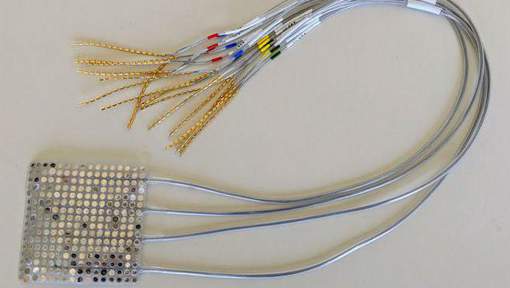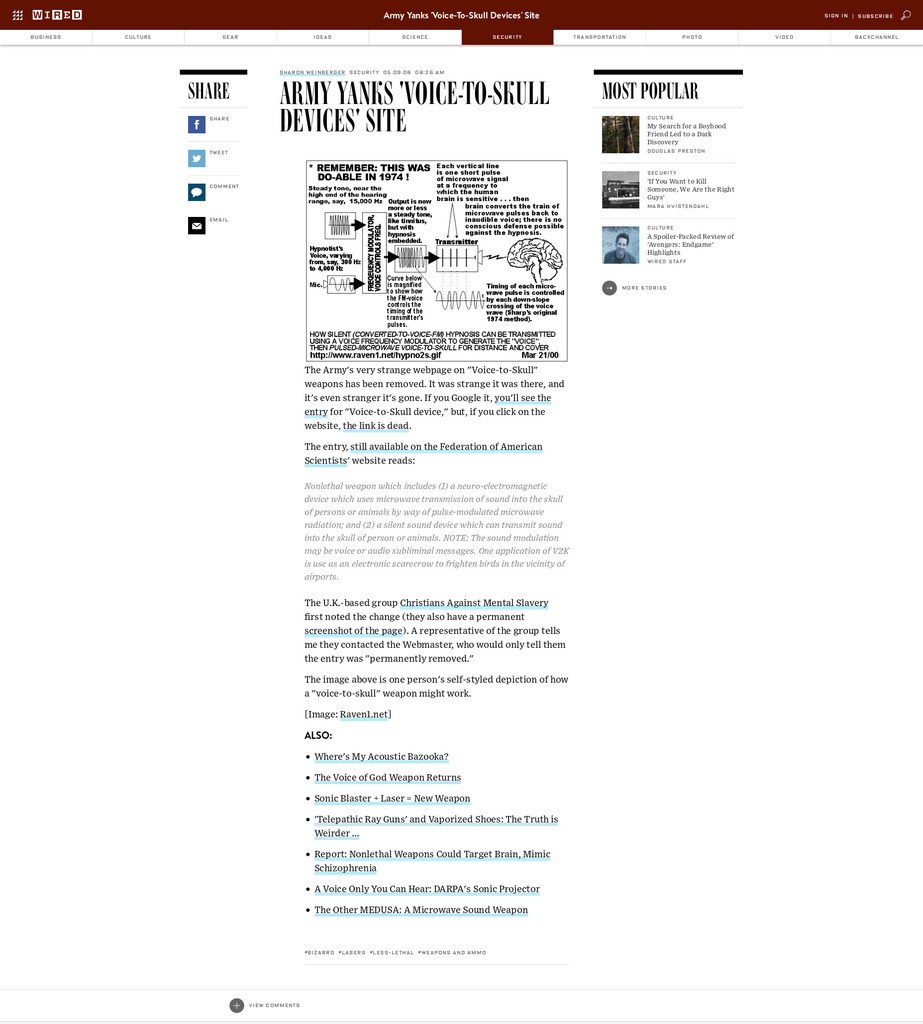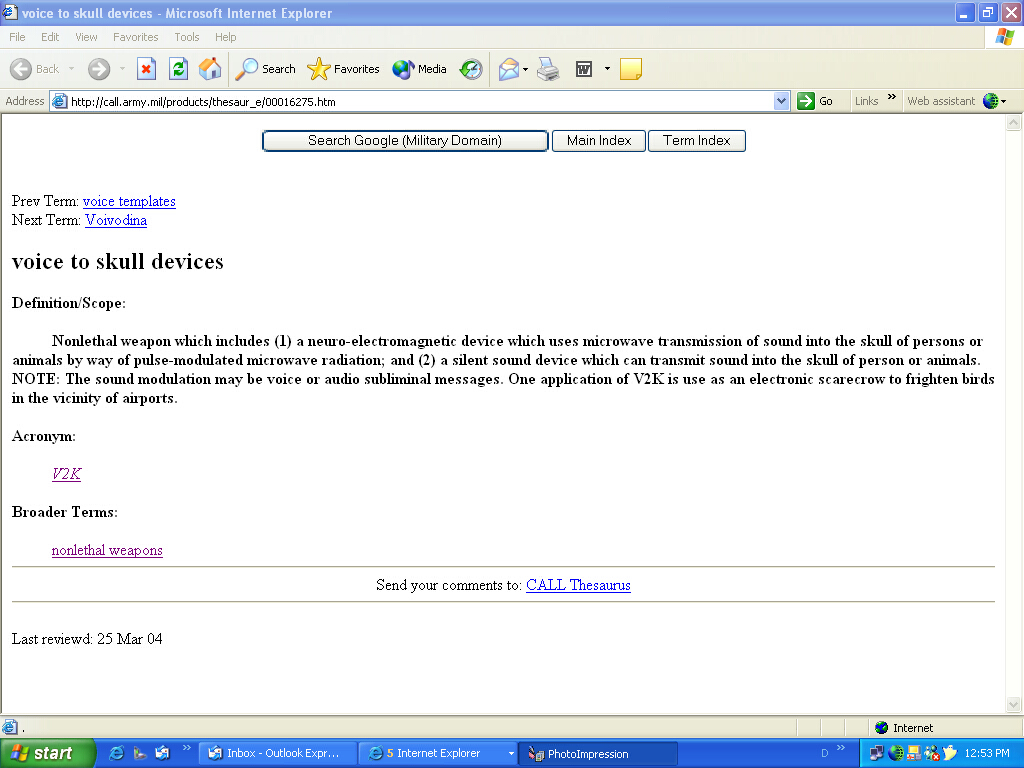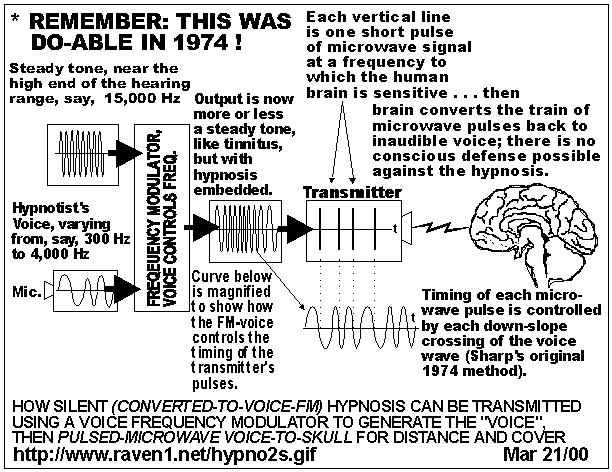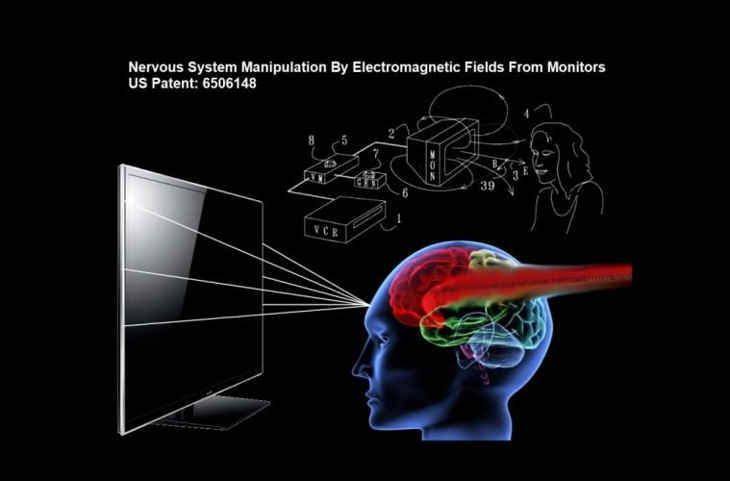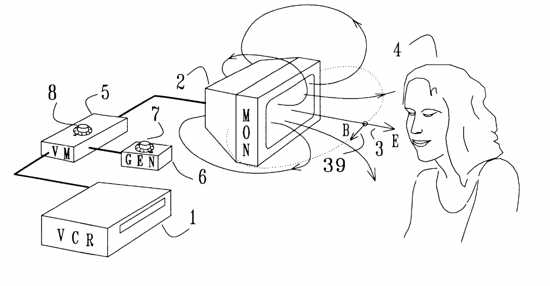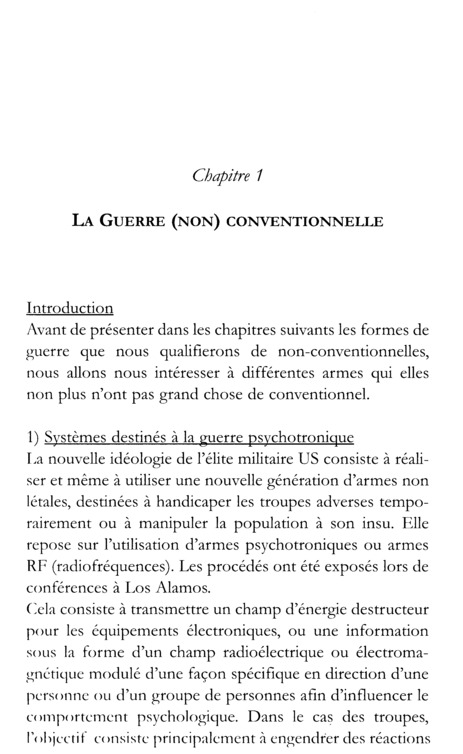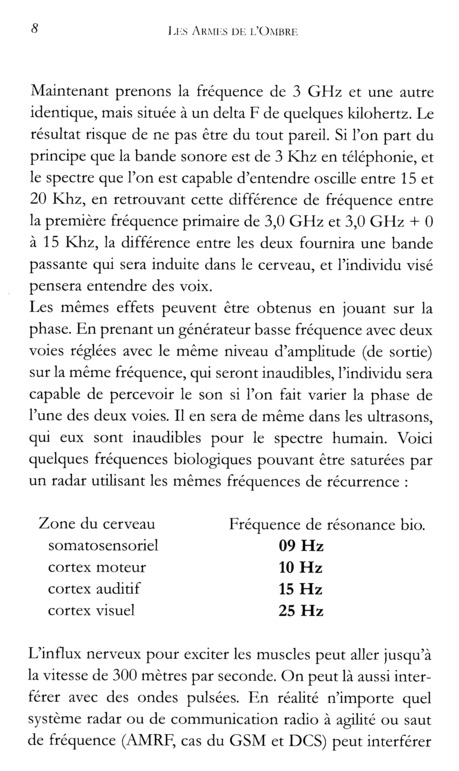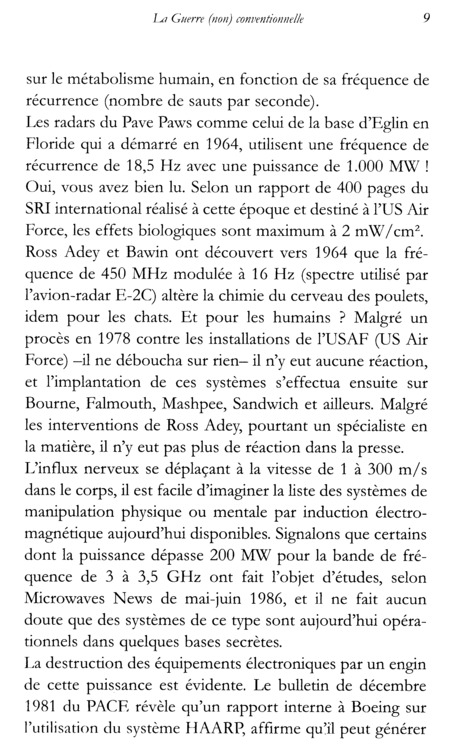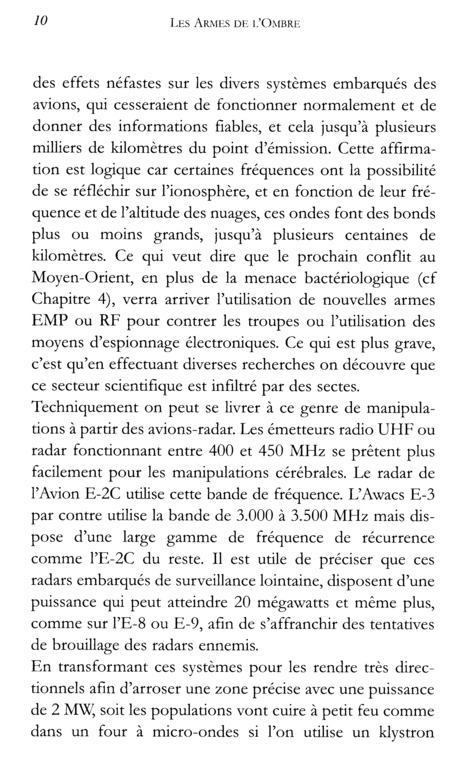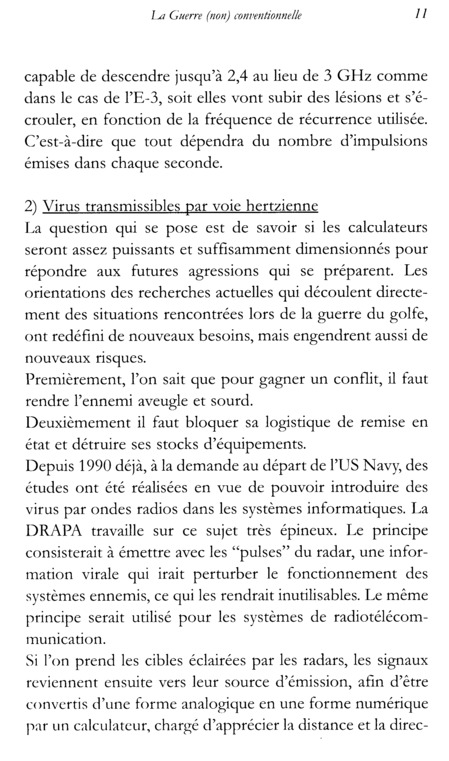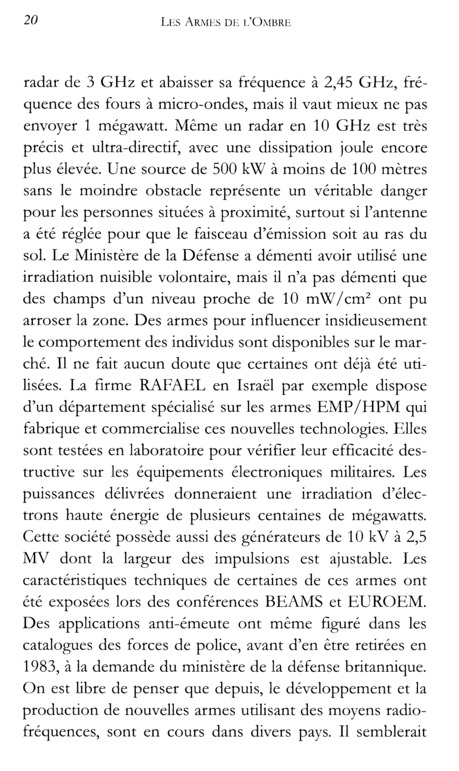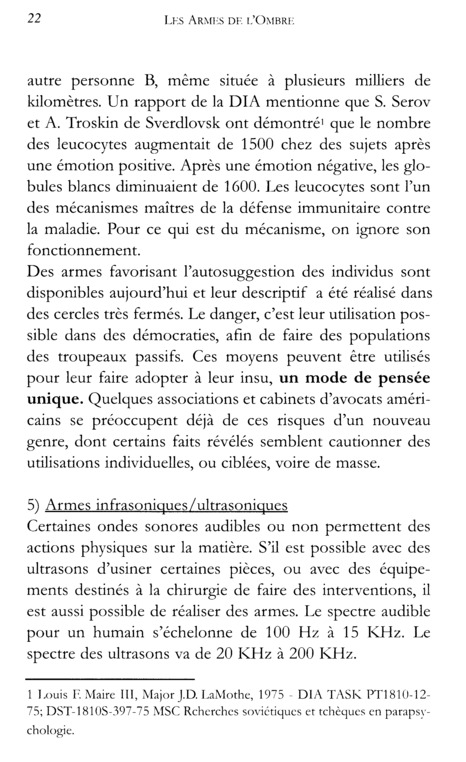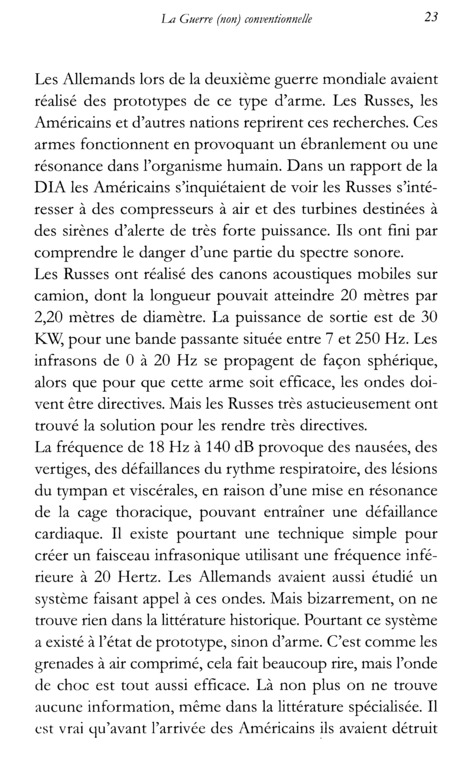Directed Energy Weapon and Electronic Warfare Relevant Patents:
Method and Device for Producing a Desired Brain State
Patent #: US6488617 B1
Publication date: Dec 3, 2002
Filing date: Oct 13, 2000
Abstract:
A method and device for the production of a desired brain state in an individual contain means for monitoring and analyzing the brain state while a set of one or more magnets produce fields that alter this state. A computational system alters various parameters of the magnetic fields in order to close the gap between the actual and desired brain state. This feedback process operates continuously until the gap is minimized and/or removed.
Pulsative Manipulation of Nervous Systems
Patent #: US6091994 A
Publication date: Jul 18, 2000
Filing date: Aug 31, 1998
Abstract:
Method and apparatus for manipulating the nervous system by imparting subliminal pulsative cooling to the subject’s skin at a frequency that is suitable for the excitation of a sensory resonance. At present, two major sensory resonances are known, with frequencies near 1/2 Hz and 2.4 Hz. The 1/2 Hz sensory resonance causes relaxation, sleepiness, ptosis of the eyelids, a tonic smile, a « knot » in the stomach, or sexual excitement, depending on the precise frequency used. The 2.4 Hz resonance causes the slowing of certain cortical activities, and is characterized by a large increase of the time needed to silently count backward from 100 to 60, with the eyes closed. The invention can be used by the general public for inducing relaxation, sleep, or sexual excitement, and clinically for the control and perhaps a treatment of tremors, seizures, and autonomic system disorders such as panic attacks. Embodiments shown are a pulsed fan to impart subliminal cooling pulses to the subject’s skin, and a silent device which induces periodically varying flow past the subject’s skin, the flow being induced by pulsative rising warm air plumes that are caused by a thin resistive wire which is periodically heated by electric current pulses.
Multifunctional Radio Frequency Directed Energy System
Patent #: US7629918 B2
Publication date: Dec 8, 2009
Filing date: Dec 15, 2005
Abstract:
An RFDE system includes an RFDE transmitter and at least one RFDE antenna. The RFDE transmitter and antenna direct high power electromagnetic energy towards a target sufficient to cause high energy damage or disruption of the target. The RFDE system further includes a targeting system for locating the target. The targeting system includes a radar transmitter and at least one radar antenna for transmitting and receiving electromagnetic energy to locate the target. The RFDE system also includes an antenna pointing system for aiming the at least one RFDE antenna at the target based on the location of the target as ascertained by the targeting system. Moreover, at least a portion of the radar transmitter or the at least one radar antenna is integrated within at least a portion of the RFDE transmitter or the at least one RFDE antenna.
Method and Device for Implementing the Radio Frequency Hearing Effect
Patent #: US6470214 B1
Publication date: Oct 22, 2002
Filing date: Dec 13, 1996
Abstract:
A modulation process with a fully suppressed carrier and input preprocessor filtering to produce an encoded output; for amplitude modulation (AM) and audio speech preprocessor filtering, intelligible subjective sound is produced when the encoded signal is demodulated using the RF Hearing Effect. Suitable forms of carrier suppressed modulation include single sideband (SSB) and carrier suppressed amplitude modulation (CSAM), with both sidebands present.
Apparatus for Audibly Communicating Speech Using the Radio Frequency Hearing Effect
Patent #: US6587729 B2
Publication date: Jul 1, 2003
Filing date: Apr 24, 2002
Abstract:
A modulation process with a fully suppressed carrier and input preprocessor filtering to produce an encoded output; for amplitude modulation (AM) and audio speech preprocessor filtering, intelligible subjective sound is produced when the encoded signal is demodulated using the RF Hearing Effect. Suitable forms of carrier suppressed modulation include single sideband (SSB) and carrier suppressed amplitude modulation (CSAM), with both sidebands present.
[RF Energy] Hearing Systems
Patent #: US3629521 A
Publication date: Dec 21, 1971
Filing date: Jan 8, 1970
Abstract:
The present invention relates to the stimulation of the sensation of hearing in persons of impaired hearing abilities or in certain cases persons totally deaf utilizing RF energy. More particularly, the present invention relates to a method and apparatus for imparting synchronous AF or « »acoustic » signals and so-called « transdermal » or RF signals. Hearing and improved speech discrimination, in accordance with one aspect of the present invention, is stimulated by the application of an AF acoustical signal to the « ear system » conventional biomechanism of hearing, which is delivered to the brain through the « normal » channels of hearing and a separate transdermal RF electrical signal which is applied to the « facial nerve system » and is detectable as a sensation of hearing. Vastly improved and enhanced hearing may be achieved…
Microwave Hearing Device
Patent #: US4858612 A
Publication date: Aug 22, 1989
Filing date: Dec 19, 1983
Abstract:
A method and apparatus for simulation of hearing in mammals by introduction of a plurality of microwaves into the region of the auditory cortex is shown and described. A microphone is used to transform sound signals into electrical signals which are in turn analyzed and processed to provide controls for generating a plurality of microwave signals at different frequencies. The multifrequency microwaves are then applied to the brain in the region of the auditory cortex. By this method sounds are perceived by the mammal which are representative of the original sound received by the microphone.
[Microwave] Hearing System
Patent #: US4877027 A
Publication date: Oct 31, 1989
Filing date: Jun 6, 1988
Abstract:
Sound is induced in the head of a person by radiating the head with microwaves in the range of 100 megahertz to 10,000 megahertz that are modulated with a particular waveform. The waveform consists of frequency modulated bursts. Each burst is made up of ten to twenty uniformly spaced pulses grouped tightly together. The burst width is between 500 nanoseconds and 100 microseconds. The pulse width is in the range of 10 nanoseconds to 1 microsecond. The bursts are frequency modulated by the audio input to create the sensation of hearing in the person whose head is irradiated.
Communication System and Method Including Brain Wave Analysis and/or use of Brain Activity
Patent #: US6011991 A
Publication date: Jan 4, 2000
Filing date: Dec 7, 1998
Abstract:
A system and method for enabling human beings to communicate by way of their monitored brain activity. The brain activity of an individual is monitored and transmitted to a remote location (e.g. by satellite). At the remote location, the monitored brain activity is compared with pre-recorded normalized brain activity curves, waveforms, or patterns to determine if a match or substantial match is found. If such a match is found, then the computer at the remote location determines that the individual was attempting to communicate the word, phrase, or thought corresponding to the matched stored normalized signal.
Apparatus and Method for Remotely Monitoring and Altering Brain Waves
Patent #: US3951134 A
Publication date: Apr 20, 1976
Filing date: Aug 5, 1974
Abstract:
Apparatus for and method of sensing brain waves at a position remote from a subject whereby electromagnetic signals of different frequencies are simultaneously transmitted to the brain of the subject in which the signals interfere with one another to yield a waveform which is modulated by the subject’s brain waves. The interference waveform which is representative of the brain wave activity is re-transmitted by the brain to a receiver where it is demodulated and amplified. The demodulated waveform is then displayed for visual viewing and routed to a computer for further processing and analysis. The demodulated waveform also can be used to produce a compensating signal which is transmitted back to the brain to effect a desired change in electrical activity therein
Method and Apparatus for the Detection of Objects Using Electromagnetic Wave Attenuation Patterns
Patent #: US7952511 B1
Publication date: May 31st 2011
Filing date: April 7th 1999
Abstract:
A method for detecting an object, comprising the steps of defining expected characteristics of scattered electromagnetic radiation to be received at a receiver; attenuating at least a portion of electromagnetic radiation received at the receiver by a presence of an object within a path of electromagnetic information; and detecting the attenuation to indicate a presence of the object. The object may be a low radar profile object, such as a stealth aircraft. The electromagnetic radiation is preferably microwave, but may also be radio frequency or infrared. By using triangulation and other geometric techniques, distance and position of the object may be computed.
Method and Device for Interpreting Concepts and Conceptual Thought from Brainwave Data and for Assisting for Diagnosis of Brainwave Disfunction
Patent #: US5392788 A
Publication date: Feb 28, 1995
Filing date: Feb 3, 1993
Abstract:
A system for acquisition and decoding of EP and SP signals is provided which comprises a transducer for presenting stimuli to a subject, EEG transducers for recording brainwave signals from the subject, a computer for controlling and synchronizing stimuli presented to the subject and for concurrently recording brainwave signals, and either interpreting signals using a model for conceptual perceptional and emotional thought to correspond EEG signals to thought of the subject or comparing signals to normative EEG signals from a normative population to diagnose and locate the origin of brain dysfunctional underlying perception, conception, and emotion.
Dream State Teaching Machine
Patent #: US5551879 A
Publication date: Sep 3, 1996
Filing date: Sep 16, 1994
Abstract:
A device for enhancing lucidity in the dream state of an individual. The device includes electronic circuitry incorporated into a headband for the user to wear while sleeping. The circuitry includes a detector for fitting adjacent to the eye of the sleeping individual, for detecting Rapid Eye Movement (REM), which occurs during the dream state. The detector emits a signal that is evaluated by additional circuitry to determine whether or not REM sleep is occurring. If REM sleep is occurring, a signal is generated to operate a recorded, which typically plays prerecorded messages through the headphones engaging the ear of the sleeping individual.
Non-contact Vital Signs Monitor
Patent #: US4958638 A
Publication date: Sep 25, 1990
Filing date: Jun 30, 1988
Abstract:
An apparatus for measuring simultaneous physiological parameters such as heart rate and respiration without physically connecting electrodes or other sensors to the body. A beam of frequency modulated continuous wave radio frequency energy is directed towards the body of a subject. The reflected signal contains phase information representing the movement of the surface of the body, from which respiration and heartbeat information can be obtained. The reflected phase modulated energy is received and demodulated by the apparatus using synchronous quadrature detection. The quadrature signals so obtained are then signal processed to obtain the heartbeat and respiratory information of interest.
Biolayer Interferometry Measurement of Biological Targets
Patent #: US8512950 B2
Publication date: Aug 20, 2013
Filing date: Jul 20, 2011
Abstract:
Disclosed are methods and compositions for the ultrasensitive detection of oligonucleotides, proteins, protein complexes, biomolecules, and infectious agents using a peroxidase driven deposition of substrates onto interferometry capable biosensors, coupled to the specific recognition of the target molecules. More specifically, methods are disclosed to specifically immobilize biological target molecules onto the surface of interferometry capable biosensors and to associate the target molecules with peroxidase enzymes. Through the peroxidase driven deposition of substrates onto the interferometry capable biosensors there is the ability to achieve ultrasensitive detection and quantification of specific target molecules.
Cold Atom Interferometry Sensor
Patent #: US8373112 B2
Publication date: Feb 12, 2013
Filing date: Mar 11, 2009
Abstract:
The disclosure relates to a cold atom interferometry sensor that includes: a source of atoms; a dual-frequency laser capable of generating a first Raman dual-frequency laser beam; a reflector arranged so as to reflect the first Raman dual-frequency laser beam in order to generate a second Raman dual-frequency laser beam, the first laser beam and the second laser beam propagating in different directions in order to obtain atomic interference fringes from the emission of cold atoms obtained from the atom source; characterized in that the reflector is further arranged so as to enable multiple reflections of the first beam on surfaces of the reflector, so that the first beam and the multiple reflections thereof allow the capture of atoms from the atom source in order to obtain the cold atoms.
Therapeutic Behavior Modification Program, Compliance Monitoring and Feedback System
Patent #: US6039688 A
Publication date: Mar 21, 2000
Filing date: Oct 31, 1997
Abstract:
A therapeutic behavior modification program, compliance monitoring and feedback system includes a server-based relational database and one or more microprocessors electronically coupled to the server. The system enables development of a therapeutic behavior modification program having a series of milestones for an individual to achieve lifestyle changes necessary to maintain his or her health or recover from ailments or medical procedures. The program may be modified by a physician or trained case advisor prior to implementation. The system monitors the individual’s compliance with the program by prompting the individual to enter health-related data, correlating the individual’s entered data with the milestones in the behavior modification program and generating compliance data indicative of the individual’s progress toward achievement of the program milestones. The system also includes an integrated system of graphical system interfaces for motivating the individual to comply with the program. Through the interfaces, the individual can access the database to review the compliance data and obtain health information from a remote source such as selected sites on the Internet. The system also provides an electronic calendar integrated with the behavior modification program for signaling the individual to take action pursuant to the behavior modification program in which the calendar accesses the relational database and integrates requirements of the program with the individual’s daily schedule, and an electronic journal for enabling the individual to enter personal health-related information into the system on a regular basis. In addition, the system includes an electronic meeting room for linking the individual to a plurality of other individuals having related behavior modification programs for facilitating group peer support sessions for compliance with the program. The system enables motivational media presentations to be made to the individuals in the electronic meeting room as part of the group support session to facilitate interactive group discussion about the presentations. The entire system is designed around a community of support motif including a graphical electronic navigator operable by the individual to control the microprocessor for accessing different parts of the system.
FM Theta-inducing Audible Sound, and Method, Device and Recorded Medium to Generate the Same
Patent #: US5954630 A
Publication date: Sep 21, 1999
Filing date: Sep 14, 1994
Abstract:
An audible sound of modulated wave where a very low-frequency wave of about 20 hertz or lower is superposed on an audio low-frequency wave effectively stimulates Fm theta in human brain waves to improve attention and concentration during mental tasks when auditorily administered. The audible sound is also effective in stimulation of human alpha wave when the very low-frequency wave lies within the range of about 2-10 hertz. Such audible sound is artificially obtainable by generating an electric signal which contains such a modulated wave, and transducing it into audible sound wave.
Magnetic Excitation of Sensory Resonances
Patent #: US5935054 A
Publication date: Aug 10, 1999
Filing date: Jun 7, 1995
Abstract:
The invention pertains to influencing the nervous system of a subject by a weak externally applied magnetic field with a frequency near 1/2 Hz. In a range of amplitudes, such fields can excite the 1/2 sensory resonance, which is the physiological effect involved in « rocking the baby ». The wave form of the stimulating magnetic field is restricted by conditions on the spectral power density, imposed in order to avoid irritating the brain and the risk of kindling. The method and apparatus can be used by the general public as an aid to relaxation, sleep, or arousal, and clinically for the control of tremors, seizures, and emotional disorders.
Electric Fringe Field Generator for Manipulating Nervous Systems
Patent #: US6081744 A
Publication date: Jun 27, 2000
Filing date: Jul 17, 1998
Abstract:
Apparatus and method for manipulating the nervous system of a subject through afferent nerves, modulated by externally applied weak fluctuating electric fields, tuned to certain frequencies such as to excite a resonance in neural circuits. Depending on the frequency chosen, excitation of such resonances causes in a human subject relaxation, sleepiness, sexual excitement, or the slowing of certain cortical processes. The electric field used for stimulation of the subject is induced by a pair of field electrodes charged to opposite polarity and placed such that the subject is entirely outside the space between the field electrodes. Such configuration allows for very compact devices where the field electrodes and a battery-powered voltage generator are contained in a small casing, such as a powder box. The stimulation by the weak external electric field relies on frequency modulation of spontaneous spiking patterns of afferent nerves. The method and apparatus can be used by the general public as an aid to relaxation, sleep, or arousal, and clinically for the control and perhaps the treatment of tremors and seizures, and disorders of the autonomic nervous system, such as panic attacks.
Brain Wave Inducing System
Patent #: US5954629 A
Publication date: Sep 21, 1999
Filing date: January 31, 1997
Abstract:
Sensors are provided for detecting brain waves of a user, and a band-pass filter is provided for extracting a particular brain waves including an .alpha. wave included in a detected brain wave. The band-pass filter comprises a first band-pass filter having a narrow pass band, and a second band-pass filter having a wide pass band. One of the first and second band-pass filters is selected, and a stimulation signal is produced in dependency on an .alpha. wave extracted by a selected band-pass filter. In accordance with the stimulation signal, a stimulation light is emitted to the user in order to induce the user to relax or sleeping state.
Brain Wave Inducing Apparatus
Patent #: US5330414 A
Publication date: Jul 19, 1994
Filing date: Feb 11, 1992
Abstract:
A random signal generator outputs a random noise signal to a band pass filter which selectively passes frequency components in the frequency range of a desired brain wave from a subject. The output of the band pass filter is supplied to an automatic level controller. The automatic level controller sets the output of band pass filter to a predetermined amplitude. Then, the output of the automatic level controller is fed to a stimulating light generator, which converts the output of the automatic level controller into a light signal for stimulating the subject in order to induce the desired brain wave from the subject. The light signal is then emitted into the subject’s eyes.
Method and an Associated Apparatus for Remotely Determining Information as to Person’s Emotional State
Patent #: US5507291 A
Publication date: Apr 16, 1996
Filing date: Apr 5, 1994
Abstract:
In a method for remotely determining information relating to a person’s emotional state, an waveform energy having a predetermined frequency and a predetermined intensity is generated and wirelessly transmitted towards a remotely located subject. Waveform energy emitted from the subject is detected and automatically analyzed to derive information relating to the individual’s emotional state. Physiological or physical parameters of blood pressure, pulse rate, pupil size, respiration rate and perspiration level are measured and compared with reference values to provide information utilizable in evaluating interviewee’s responses or possibly criminal intent in security sensitive areas.
Method of and Apparatus for Inducing Desired States of Consciousness
Patent #: US5356368 A
Publication date: Oct 18, 1994
Filing date: Mar 1, 1991
Abstract:
Improved methods and apparatus for entraining human brain patterns, employing frequency following response (FFR) techniques, facilitate attainment of desired states of consciousness. In one embodiment, a plurality of electroencephalogram (EEG) waveforms, characteristic of a given state of consciousness, are combined to yield an EEG waveform to which subjects may be susceptible more readily. In another embodiment, sleep patterns are reproduced based on observed brain patterns during portions of a sleep cycle; entrainment principles are applied to induce sleep. In yet another embodiment, entrainment principles are applied in the work environment, to induce and maintain a desired level of consciousness. A portable device also is described.
Method and Apparatus for Analyzing Neurological Response to Emotion-inducing Stimuli
Patent #: US6292688 B1
Publication date: Sep 18, 2001
Filing date: Feb 28, 1996
Abstract:
A method of determining the extent of the emotional response of a test subject to stimului having a time-varying visual content, for example, an advertising presentation. The test subject is positioned to observe the presentation for a given duration, and a path of communication is established between the subject and a brain wave detector/analyzer. The intensity component of each of at least two different brain wave frequencies is measured during the exposure, and each frequency is associated with a particular emotion. While the subject views the presentation, periodic variations in the intensity component of the brain waves of each of the particular frequencies selected is measured. The change rates in the intensity at regular periods during the duration are also measured. The intensity change rates are then used to construct a graph of plural coordinate points, and these coordinate points graphically establish the composite emotional reaction of the subject as the presentation continues.
Nervous System Manipulation by Electromagnetic Fields from Monitors
Patent #: US6506148 B2
Publication date: Jan 14, 2003
Filing date: Jun 1, 2001
Abstract:
Physiological effects have been observed in a human subject in response to stimulation of the skin with weak electromagnetic fields that are pulsed with certain frequencies near ½ Hz or 2.4 Hz, such as to excite a sensory resonance. Many computer monitors and TV tubes, when displaying pulsed images, emit pulsed electromagnetic fields of sufficient amplitudes to cause such excitation. It is therefore possible to manipulate the nervous system of a subject by pulsing images displayed on a nearby computer monitor or TV set. For the latter, the image pulsing may be imbedded in the program material, or it may be overlaid by modulating a video stream, either as an RF signal or as a video signal. The image displayed on a computer monitor may be pulsed effectively by a simple computer program. For certain monitors, pulsed electromagnetic fields capable of exciting sensory resonances in nearby subjects may be generated even as the displayed images are pulsed with subliminal intensity.
Psycho-Acoustic Projector
Patent #: US3566347 A
Publication date: Feb 23, 1971
Filing date: Apr 27, 1967
Abstract:
A system for producing aural psychological disturbances and partial deafness in the enemy during combat situations.
Method of Inducing Harmonious States of Being
Patent #: US6135944 A
Publication date: Oct 24, 2000
Filing date: Nov 6, 1998
Abstract:
A method of inducing harmonious states of being using vibrational stimuli, preferably sound, comprised of a multitude of frequencies expressing a specific pattern of relationship. Two base signals are modulated by a set of ratios to generate a plurality of harmonics. The harmonics are combined to form a « fractal » arrangement.
Method and System for Altering Consciousness
Patent #: US5123899 A
Publication date: Jun 23, 1992
Filing date: Jan 17, 1991
Abstract:
A system for altering the states of human consciousness involves the simultaneous application of multiple stimuli, preferable sounds, having differing frequencies and wave forms. The relationship between the frequencies of the several stimuli is exhibited by the equation
g=sn/4 ·f
where:
f=frequency of one stimulus;
g=frequency of the other stimuli of stimulus; and
n=a positive or negative integer which is different for each other stimulus.
Silent Subliminal Presentation System
Patent #: US5159703 A
Publication date: Oct 27, 1992
Filing date: Dec 28, 1989
Abstract:
A silent communications system in which nonaural carriers, in the very low or very high audio frequency range or in the adjacent ultrasonic frequency spectrum, are amplitude or frequency modulated with the desired intelligence and propagated acoustically or vibrationally, for inducement into the brain, typically through the use of loudspeakers, earphones or piezoelectric transducers. The modulated carriers may be transmitted directly in real time or may be conveniently recorded and stored on mechanical, magnetic or optical media for delayed or repeated transmission to the listener.
Subliminal Acoustic Manipulation of Nervous Systems
Patent #: US6017302 A
Publication date: Jan 25, 2000
Filing date: Oct 31, 1997
Abstract:
In human subjects, sensory resonances can be excited by subliminal atmospheric acoustic pulses that are tuned to the resonance frequency. The 1/2 Hz sensory resonance affects the autonomic nervous system and may cause relaxation, drowsiness, or sexual excitement, depending on the precise acoustic frequency near 1/2 Hz used. The effects of the 2.5 Hz resonance include slowing of certain cortical processes, sleepiness, and disorientation. For these effects to occur, the acoustic intensity must lie in a certain deeply subliminal range. Suitable apparatus consists of a portable battery-powered source of weak subaudio acoustic radiation. The method and apparatus can be used by the general public as an aid to relaxation, sleep, or sexual arousal, and clinically for the control and perhaps treatment of insomnia, tremors, epileptic seizures, and anxiety disorders. There is further application as a nonlethal weapon that can be used in law enforcement standoff situations, for causing drowsiness and disorientation in targeted subjects. It is then preferable to use venting acoustic monopoles in the form of a device that inhales and exhales air with subaudio frequency.
Apparatus and Method of Broadcasting Audible Sound using Ultrasonic Sound as a Carrier
Patent #: US6052336 A
Publication date: Apr 18, 2000
Filing date: May 1, 1998
Abstract:
An ultrasonic sound source broadcasts an ultrasonic signal which is amplitude and/or frequency modulated with an information input signal originating from an information input source. If the signals are amplitude modulated, a square root function of the information input signal is produced prior to modulation. The modulated signal, which may be amplified, is then broadcast via a projector unit, whereupon an individual or group of individuals located in the broadcast region detect the audible sound.
FM Theta-inducing Audible Sound, and Method, Device and Recorded Medium to Generate the Same
Patent #: US5954630 A
Publication date: Sep 21, 1999
Filing date: Sep 14, 1994
Abstract:
An audible sound of modulated wave where a very low-frequency wave of about 20 hertz or lower is superposed on an audio low-frequency wave effectively stimulates Fm theta in human brain waves to improve attention and concentration during mental tasks when auditorily administered. The audible sound is also effective in stimulation of human alpha wave when the very low-frequency wave lies within the range of about 2-10 hertz. Such audible sound is artificially obtainable by generating an electric signal which contains such a modulated wave, and transducing it into audible sound wave.
Apparatus for Electric Stimulation of Auditory Nerves of a Human Being
Patent #: US5922016 A
Publication date: Jul 13, 1999
Filing date: Jan 26, 1996
Abstract:
Apparatus for electric stimulation and diagnostics of auditory nerves of a human being, e.g. for determination of sensation level (SL), most conformable level (MCL) and uncomfortable level (UCL) audibility curves, includes a stimulator detachably secured to a human being for sending a signal into a human ear, and an electrode placed within the human ear and electrically connected to the stimulator by an electric conductor for conducting the signals from the stimulator into the ear. A control unit is operatively connected to the stimulator for instructing the stimulator as to characteristics of the generated signals being transmitted to the ear.
Method and Apparatus for Introducing Subliminal Changes to Audio Stimuli
Patent #: US5215468 A
Publication date: Jun 1, 1993
Filing date: Mar 11, 1991
Abstract:
A method and apparatus for introducing gradual changes to an audio signal so that the changes are subliminal. The changes can involve tempo and volume, for example, and can take the form of a gentle gradient having ever increasing/decreasing ramp-like changes over a sufficient duration, or a more complex program involving several gentle gradients. In the preferred embodiment, an enhanced audio play-back device such as a portable audio cassette recorder can be programmed to subliminally alter the characteristics of a standard pre-recorded tape containing music, for example. As a motivational tool during walking, jogging or other repetitive exercise, the tempo is gradually increased over a period of time to encourage a corresponding gradual (and subliminal) increase in physical exertion by a user whose rate of movement is proportional to the tempo of the music. The tempo can be either manually changed in conjunction with a subliminal program, or by itself in an override mode, or by itself in a version of the present-inventive audio play-back device which allows only manual tempo alternation. In an alternate embodiment, a special pre-recorded tape contains subliminal changes in tempo, for example, for play-back on a standard audio cassette recorder (which operates at one speed, only) to cause the same effect as the preferred embodiment.
Method and Recording for Producing Sounds and Messages to Achieve Alpha and Theta Brainwave States and Positive Emotional States in Humans
Patent #: US5586967 A
Publication date: Dec 24, 1996
Filing date: Jun 27, 1994
Abstract:
A method and recording for the use in achieving alpha and theta brainwave states and effecting positive emotional states in humans, is provided which includes a medium having a musical composition thereon with an initial tempo decreasing to a final tempo and verbal phrases recorded in synchrony with the decreasing tempo.
Ultrasonic Speech Translator and Communications System
Patent #: US5539705 A
Publication date: Jul 23, 1996
Filing date: Oct 27, 1994
Abstract:
A wireless communication system undetectable by radio frequency methods for converting audio signals, including human voice, to electronic signals in the ultrasonic frequency range, transmitting the ultrasonic signal by way of acoustical pressure waves across a carrier medium, including gases, liquids, or solids, and reconverting the ultrasonic acoustical pressure waves back to the original audio signal. The ultrasonic speech translator and communication system (20) includes an ultrasonic transmitting device (100) and an ultrasonic receiving device (200). The ultrasonic transmitting device (100) accepts as input (115) an audio signal such as human voice input from a microphone (114) or tape deck. The ultrasonic transmitting device (100) frequency modulates an ultrasonic carrier signal with the audio signal producing a frequency modulated ultrasonic carrier signal, which is transmitted via acoustical pressure waves across a carrier medium such as gases, liquids or solids. The ultrasonic receiving device (200) converts the frequency modulated ultrasonic acoustical pressure waves to a frequency modulated electronic signal, demodulates the audio signal from the ultrasonic carrier signal, and conditions the demodulated audio signal to reproduce the original audio signal at its output (250).
Apparatus Particularly for use in the Determination of the Condition of the Vegetative part of the Nervous System
Patent #: US5522386 A
Publication date: Jun 4, 1996
Filing date: Apr 29, 1992
Abstract:
Apparatus for use in the determination of the condition of the vegetative part of the nervous system and/or of sensory functions of an organism, i.e. a human being or animal. The apparatus comprises devices for generating and supplying to said organism at least one sensory stimulus chosen from a group of sensory stimuli, such as visual, sound, olfactory, gustatory, tactile or pain stimuli, and devices for measuring the skin potential and the evoked response of the organism to a stimulus. The measured data are processed by processing devices for automatically controlling the supply of at least one stimulus for providing a non-rhythmical sequence of stimuli. Preferably, pairs of stimuli are supplied for developing a conditioned reflex.
Method of Inducing Mental, Emotional and Physical States of Consciousness, Including Specific Mental Activity, in Human Beings
Patent #: US5213562 A
Publication date: May 25, 1993
Filing date: Apr 25, 1990
Abstract:
A method having applicability in replication of desired consciousness states; in the training of an individual to replicate such a state of consciousness without further audio stimulation; and in the transferring of such states from one human being to another through the imposition of one individual’s EEG, superimposed on desired stereo signals, on another individual, by inducement of a binaural beat phenomenon.
Silent Subliminal Presentation System
Patent #: US5159703 A
Publication date: Oct 27, 1992
Filing date: Dec 28, 1989
Abstract:
A silent communications system in which nonaural carriers, in the very low or very high audio frequency range or in the adjacent ultrasonic frequency spectrum, are amplitude or frequency modulated with the desired intelligence and propagated acoustically or vibrationally, for inducement into the brain, typically through the use of loudspeakers, earphones or piezoelectric transducers. The modulated carriers may be transmitted directly in real time or may be conveniently recorded and stored on mechanical, magnetic or optical media for delayed or repeated transmission to the listener.
Method and Apparatus for Inducing and Establishing a Changed State of Consciousness
Patent #: US5151080 A
Publication date: Sep 29, 1992
Filing date: Aug 28, 1990
Abstract:
An electroacoustic device includes a sound generator as well as a system for producing synthetic human speech, connected to a modulation stage for superimposing the output signals thereof. The superimposed output signals are applied via an amplifier stage to one of a headphone system or loudspeaker system.
Method and Apparatus of Varying the Brain State of a Person by means of an Audio Signal
Patent #: US5135468 A
Publication date: Aug 4, 1992
Filing date: Aug 2, 1990
Abstract:
A method of varying the brain state of a person includes the steps of supplying the first audio signal to one ear of the person, supplying a second audio signal to the other ear of the person, and substantially continuously varying the frequency of at least one of the first and second audio signals to vary the brain state of the person.
Method and Apparatus for Changing Brain Wave Frequency
Patent #: US5036858 A
Publication date: Aug 6, 1991
Filing date: Mar 22, 1990
Abstract:
A method for changing brain wave frequency to a desired frequency determines a current brain wave frequency of a user, generates two frequencies with a frequency difference of a magnitude between that of the current actual brain wave frequency and the desired frequency but always within a predetermined range of the current actual brain wave frequency, and produces an output to the user corresponding to the two frequencies. One apparatus to accomplish the method has a computer processor, a computer memory, EEG electrodes along with an amplifier, a programmable timing generator responsive to the computer processor for generating the two frequencies, audio amplifiers and a beat frequency generator driving a visual frequency amplifier.
Non-invasive Method and Apparatus for Modulating Brain Signals through an External Magnetic or Electric Field to Reduce Pain
Patent #: US4889526 A
Publication date: Dec 26, 1989
Filing date: Nov 13, 1987
Abstract:
This invention incorporates the discovery of new principles which utilize magnetic and electric fields generated by time varying square wave currents of precise repetition, width, shape and magnitude to move through coils and cutaneously applied conductive electrodes in order to stimulate the nervous system and reduce pain in humans. Timer means, adjustment means, and means to deliver current to the coils and conductive electrodes are described, as well as a theoretical model of the process. The invention incorporates the concept of two cyclic expanding an collapsing magnetic fields which generate precise wave forms in conjunction with each other to create a beat frequency which in turn causes the ion flow in the nervous system of the human body to be efficiency moved along the nerve path where the locus of the pain exists to thereby reduce the pain. The wave forms are create either in one or more coils, one or more pairs of electrodes, or a combination of the two.
Method and Apparatus for Translating the EEG into Music to induce and Control Carious Psychological and Physiological States and to Control a Musical Instrument
Patent #: US4883067 A
Publication date: Nov 28, 1989
Filing date: May 15, 1987
Abstract:
A method and apparatus for applying a musical feedback signal to the human brain, or any other brain, to induce controllable psychological and physiological responses. A signal representing the ongoing electroencephalographic (EEG) signal of a brain preferably is obtained from the electrode location on the scalp known as CZ or P3 in clinical notation. A signal processor converts the ongoing EEG into electrical signals which are converted into music by synthesizers. The music is acoustically fed back to the brain after a time delay calculated to shift the phase of the feedback in order to reinforce specific or desired ongoing EEG activity from the scalp position of interest. The music is comprised of at least one voice that follows the moment-by-moment contour of the EEG in real time to reinforce the desired EEG activity. The music drives the brain into resonance with the music to provide a closed loop or physiological feedback effect. Preferably, the musical feedback comprises additional voices that embody psychoacoustic principles as well as provide the content and direction normally supplied by the therapist in conventional biofeedback. The invention contemplates numerous applications for the results obtained.
Method for Stimulating the Falling Asleep and/or Relaxing Behavior of a Person and an Arrangement Therefor
Patent #: US4573449 A
Publication date: Mar 4, 1986
Filing date: Mar 8, 1983
Abstract:
A method and apparatus is provided with which a person suffering from sleeplessness can be more easily relaxed and may more rapidly fall asleep. In particular, sound pulses are emitted by an electro-acoustic transducer, according to the cadence of which, the person seeking to fall asleep is induced to breathe in and out over a predetermined period of time. By suitably selecting the pulse sequence frequency, the pitch and the amplitude of the sound pulses may be adjusted thereby enhancing the process of falling asleep.
Shadow Generating Apparatus
Patent #: US4508105 A
Publication date: Apr 2, 1985
Filing date: Feb 8, 1983
Abstract:
Disclosed is an apparatus for inducing various brain wave patterns through visual stimulation. The apparatus comprises a pair of spectacles or other viewing apparatus having a liquid crystal display embedded in each lens. By repetitively activating and deactivating the liquid crystals, shadows are generated which are perceived by the subject individual wearing the viewing apparatus. Responding to the frequency of shadow generation, the subject’s brain is thereby induced to generate sympathetic brain wave frequencies. The apparatus finds particular utility in the generation of alpha waves. Because learning is enhanced when the brain is in the alpha state, activities such as listening to tapes or lectures and the like can be carried out with greater facility. Shadow generation is accomplished through the use of a timing mechanism for each liquid crystal display and the frequency for each is adjustable over a wide range, permitting synchronous or asynchronous timing.
Method and Apparatus for Repetitively Producing a Noise-like Audible Signal
Patent #: US4191175 A
Publication date: Mar 4, 1980
Filing date: Jan 16, 1978
Abstract:
A digital pulse generator and shift register repetitively produce bursts of digital pulses at a first adjustable repetition frequency. The repetition frequency of the pulses in each burst is also adjustable. A pink noise filter accentuates the lower burst frequency components near 7 hz and substantially attenuates all frequency components of the bursts above a first cut-off point near 10 Khz. A tunable band pass amplifier having a center frequency adjustable over a preselected range of frequencies optimally detectable by the average human ear accentuates the pink noise filter output near 2.6 Khz. The tunable amplifier drives an audible signal source with noise-like pulses of varying amplitudes and frequency components. A low pass amplifier may be connected to the pink noise filter to generate a train of pulses having a repetition frequency near 7 hz which pulses a light source in synchronism with the audible noise-like signal.
Noise Generator and Transmitter
Patent #: US4034741 A
Publication date: Jul 12, 1977
Filing date: Feb 17, 1976
Abstract:
An analgesic noise generator employs a circuit that can be switched to provide a variable waveform from an active noise source out of an integrated circuit amplifier.
Multichannel System for and a Multifactorial Method of Controlling the Nervous System of a Living Organism
Patent #: US3967616 A
Publication date: Jul 6, 1976
Filing date: Sep 5, 1974
Abstract:
A novel method for controlling the nervous system of a living organism for therapeutic and research purposes, among other applications, and an electronic system utilized in, and enabling the practice of, the invented method. Bioelectrical signals generated in specifictopological areas of the organism’s nervous system, typically areas of the brain, are processed by the invented system so as to produce a sensory stimulus if the system detects the presence or absence, as the case may be, of certain characteristics in the waveform patterns of the bioelectrical signals being monitored. The coincidence of the same or different characteristics in two or more waveform patterns, or the non-coincidence thereof, may be correlated with a certain desired condition of the organism’s nervous system; likewise, with respect to the coincidence or non-coincidence of different characteristics of a single waveform pattern. In any event, the sensory stimulus provided by the invented system, typically an audio or visual stimulus, or combination thereof, is fed back to the organism which associates its presence with the goal of achieving the desired condition of its nervous system. Responding to the stimulus, the organism can be trained to control the waveform patterns of the monitored bioelectrical signals and thereby, control its own nervous system. The results of the coincidence function permit results heretofore unobtainable.
Method of Inducing and Maintaining Various Stages of Sleep in the Human Being
Patent #: US3884218 A
Publication date: May 20, 1975
Filing date: Sep 30, 1970
Abstract:
A method of inducing sleep in a human being wherein an audio signal is generated comprising a familiar pleasing repetitive sound modulated by an EEG sleep pattern. The volume of the audio signal is adjusted to overcome the ambient noise and a subject can select a familiar repetitive sound most pleasing to himself.
System and Method for Controlling the Nervous System of a Living Organism
Patent #: US3837331 A
Publication date: Sep 24, 1974
Filing date: Oct 24, 1972
Abstract:
A novel method for controlling the nervous system of a living organism for therapeutic and research purposes, among other applications, and an electronic system utilized in, and enabling the practice of the invented method. Bioelectrical signals generated in specific topological areas of the organism’s nervous system, typically areas of the brain, are processed by the invented system so as to produce an output signal which is in some way an analog of selected characteristics detected in the bioelectrical signal. The output of the system, typically an audio or visual signal, is fed back to the organism as a stimulus. Responding to the stimulus, the organism can be trained to control the waveform pattern of the bioelectrical signal generated in its own nervous system.
Method for Obtaining Neurophysiological Effects
Patent #: US3835833 A
Publication date: Sep 17, 1974
Filing date: Sep 21, 1972
Abstract:
A method and apparatus for obtaining neurophysiological effects on the central and/or peripheral systems of a patient. Electrodes are suitably positioned on the body of the patient and a composite electric signal is applied at the electrodes. The composite signal is formed by the superpositioning of two signals: a first signal which is a rectified high-frequency carrier modulated in amplitude to about 100 percent by substantially square-shaped pulses whose duration, amplitude and frequency are chosen according to the neurophysiological effects desidered, and a second signal which has a relatively white noise spectrum. The mean value of the first electric signal has a predetermined sign which is opposite the sign of the mean value of the second electric signal.
Apparatus for the Treatment of Neuropsychic and Somatic Diseases with Heat, Light, Sound and vhf Electromagnetic Radiation
Patent #: US3773049 A
Publication date: Nov 20, 1973
Filing date: Nov 13, 1970
Abstract:
An apparatus for the treatment of neuropsychic and somatic disorders wherein light-, sound-, VHF electromagnetic field-pulses and radiation from light-, sound-, VHF electromcagnetic field- and heat-sources, respectively, are simultaneously applied by means of a control unit to the patient’s central nervous system with a predermined repetition rate. The light radiation and sound radiation sources are made so as to exert an adequate and monotonous influence of the light-and sound-radiation on the patient’s visual analyzers and auditory analyzers, respectively.
Hearing Aid for Producing Sensations in the Brain
Patent #: US3766331 A
Publication date: Oct 16, 1973
Filing date: Nov 24, 1971
Abstract:
A pulsed oscillator or transmitter supplies energy to a pair of insulated electrodes mounted on a person’s neck. The transmitter produces pulses of intensity greater than a predetermined threshold value and of a width and rate so as to produce the sensation of hearing without use of the auditory canal thereby providing a hearing system enabling otherwise deaf people to hear.
Electronic System for the Stimulation of Biological Systems
Patent #: US3727616 A
Publication date: Apr 17, 1973
Filing date: Jun 15, 1971
Abstract:
A receiver totally implanted within a living body is inductively coupled by two associated receiving coils to a physically unattached external transmitter which transmits two signals of different frequencies to the receiver via two associated transmitting coils. One of the signals from the transmitter provides the implanted receiver with precise control or stimulating signals which are demodulated and processed in a signal processor network in the receiver and then used by the body for stimulation of a nerve, for example, while the other signal provides the receiver with a continuous wave power signal which is rectified in the receiver to provide a source of electrical operating power for the receiver circuitry without need for an implanted battery.
Method and Apparatus for Producing Swept Frequency-modulated Audio Signal Patterns for Inducing Sleep
Patent #: US3712292 A
Publication date: Jan 23, 1973
Filing date: Jul 20, 1971
Abstract:
A method of producing sound signals for inducing sleep in a human being, and apparatus therefor together with REPRESENTATIONS thereof in recorded form, wherein an audio signal is generated representing a familiar, pleasing, repetitive sound, modulated by continuously sweeping frequencies in two selected frequency ranges having the dominant frequencies which occur in electrical wave patterns of the human brain during certain states of sleep. The volume of the audio signal is adjusted to mask the ambient noise and the subject can select any of several familiar, repetitive sounds most pleasing to him.
Method and System for Simplifying Speech Waveforms
Patent #: US3647970 A
Publication date: Mar 7, 1972
Filing date: Aug 29, 1968
Abstract:
A speech waveform is converted to a constant amplitude square wave in which the transitions between the amplitude extremes are spaced so as to carry the speech information. The system includes a pair of tuned amplifier circuits which act as high-pass filters having a 6 decibel per octave slope from 0 to 15,000 cycles followed by two stages, each comprised of an amplifier and clipper circuit, for converting the filtered waveform to a square wave. A radio transmitter and receiver having a plurality of separate channels within a conventional single side band transmitter bandwidth and a system for transmitting secure speech information are also disclosed.
Sleep-inducing Method and Arrangement Using Modulated Sound and Light
Patent #: US3576185 A
Publication date: Apr 27, 1971
Filing date: Jun 19, 1968
Abstract:
N/A
Nervous System Excitation Device
Patent #: US3393279 A
Publication date: Jul 16, 1968
Filing date: Mar 13, 1962
Abstract:
A method of transmitting audio information via a radio frequency signal modulated with the audio info through electrodes placed on the subject’s skin, causing the sensation of hearing the audio information in the brain.
